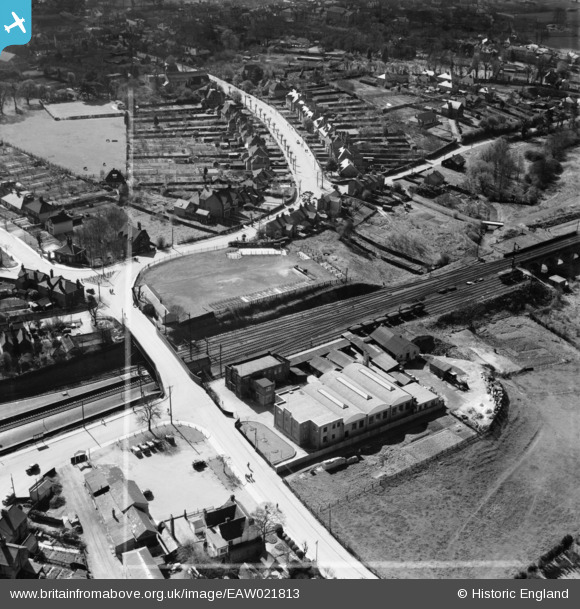EAW021813 ENGLAND (1949). W. Pinkham and Sons Ltd Glove Factory and the Cattle Market, Witham, 1949. This image was marked by Aerofilms Ltd for photo editing.
© Hawlfraint cyfranwyr OpenStreetMap a thrwyddedwyd gan yr OpenStreetMap Foundation. 2025. Trwyddedir y gartograffeg fel CC BY-SA.
Delweddau cyfagos (7)
Manylion
| Pennawd | [EAW021813] W. Pinkham and Sons Ltd Glove Factory and the Cattle Market, Witham, 1949. This image was marked by Aerofilms Ltd for photo editing. |
| Cyfeirnod | EAW021813 |
| Dyddiad | 9-April-1949 |
| Dolen | |
| Enw lle | WITHAM |
| Plwyf | WITHAM |
| Ardal | |
| Gwlad | ENGLAND |
| Dwyreiniad / Gogleddiad | 581953, 215065 |
| Hydred / Lledred | 0.63939374665526, 51.804125838154 |
| Cyfeirnod Grid Cenedlaethol | TL820151 |
Pinnau

Matt Aldred edob.mattaldred.com |
Thursday 20th of March 2025 09:26:38 PM | |

Matt Aldred edob.mattaldred.com |
Thursday 20th of March 2025 09:26:02 PM | |

Billy Turner |
Thursday 18th of February 2016 09:41:47 PM | |

Billy Turner |
Thursday 18th of February 2016 06:56:45 PM | |

Billy Turner |
Thursday 18th of February 2016 01:39:05 PM |


![[EAW021813] W. Pinkham and Sons Ltd Glove Factory and the Cattle Market, Witham, 1949. This image was marked by Aerofilms Ltd for photo editing.](http://britainfromabove.org.uk/sites/all/libraries/aerofilms-images/public/100x100/EAW/021/EAW021813.jpg)
![[EAW021814] W. Pinkham and Sons Ltd Glove Factory and the Cattle Market, Witham, 1949. This image was marked by Aerofilms Ltd for photo editing.](http://britainfromabove.org.uk/sites/all/libraries/aerofilms-images/public/100x100/EAW/021/EAW021814.jpg)
![[EAW021815] W. Pinkham and Sons Ltd Glove Factory, Witham, 1949. This image was marked by Aerofilms Ltd for photo editing.](http://britainfromabove.org.uk/sites/all/libraries/aerofilms-images/public/100x100/EAW/021/EAW021815.jpg)
![[EAW021812] W. Pinkham and Sons Ltd Glove Factory, Witham, 1949. This image was marked by Aerofilms Ltd for photo editing.](http://britainfromabove.org.uk/sites/all/libraries/aerofilms-images/public/100x100/EAW/021/EAW021812.jpg)
![[EAW021811] W. Pinkham and Sons Ltd Glove Factory, Witham, 1949. This image was marked by Aerofilms Ltd for photo editing.](http://britainfromabove.org.uk/sites/all/libraries/aerofilms-images/public/100x100/EAW/021/EAW021811.jpg)
![[EAW021810] W. Pinkham and Sons Ltd Glove Factory, Witham, 1949](http://britainfromabove.org.uk/sites/all/libraries/aerofilms-images/public/100x100/EAW/021/EAW021810.jpg)
![[EAW021809] W. Pinkham and Sons Ltd Glove Factory, Witham, 1949](http://britainfromabove.org.uk/sites/all/libraries/aerofilms-images/public/100x100/EAW/021/EAW021809.jpg)


